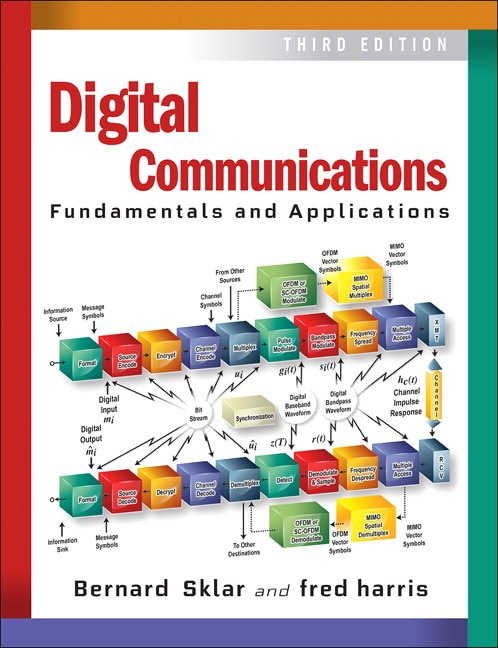
Digital Communications: Fundamentals and Applications, 3rd edition
- Bernard Sklar
- , Fredric J. Harris

- Listen on the go
Learn how you like with full eTextbook audio
- Find it fast
Quickly navigate your eTextbook with search
- Stay organized
Access all your eTextbooks in one place
- Easily continue access
Keep learning with auto-renew
Preface xvii
Acknowledgments xxi
About the Authors xxiii
Part I: Prerequisites 1
Chapter 1: Introduction 3
1.1 The Frontier: Millimeter Wave Wireless 31.2 A Preview of MmWave Implementation Challenges 17
1.3 Emerging Applications of MmWave Communications 19
1.4 Contributions of This Textbook 27
1.5 Outline of This Textbook 28
1.6 Symbols and Common De_nitions 31
1.7 Chapter Summary 32
Chapter 2: Wireless Communication Background 33
2.1 Introduction 332.2 Complex Baseband Representation 34
2.3 Digital Modulation 39
2.4 Equalization in the Time Domain 49
2.5 Equalization in the Frequency Domain 56
2.6 Error Control Coding 62
2.7 Estimation and Synchronization 72
2.8 Multiple Input Multiple Output (MIMO) Communication 81
2.9 Hardware Architectures 88
2.10 System Architecture 91
2.11 Chapter Summary 95
Part II: Fundamentals 97
Chapter 3: Radio Wave Propagation for MmWave 99
3.1 Introduction 993.2 Large-Scale Propagation Channel E_ects 101
3.3 Small-Scale Channel E_ects 126
3.4 Spatial Characterization of Multipath and Beam Combining 132
3.5 Angle Spread and Multipath Angle of Arrival 135
3.6 Antenna Polarization 138
3.7 Outdoor Channel Models 139
3.8 Indoor Channel Models 166
3.9 Chapter Summary 184
Chapter 4: Antennas and Arrays for MmWave Applications 187
4.1 Introduction 187
4.2 Fundamentals of On-Chip and In-Package MmWave Antennas 189
4.3 The On-Chip Antenna Environment 198
4.4 In-Package Antennas 209
4.5 Antenna Topologies for MmWave Communications 211
4.6 Techniques to Improve Gain of On-Chip Antennas 225
4.7 Adaptive Antenna Arrays | Implementations for MmWave Communications 235
4.8 Characterization of On-Chip Antenna Performance 252
4.9 Chapter Summary 257
Chapter 5: MmWave RF and Analog Devices and Circuits 259
5.1 Introduction 259
5.2 Basic Concepts for MmWave Transistors and Devices 260
5.3 S-Parameters, Z-Parameters, Y-Parameters, and ABCD-Parameters 263
5.4 Simulation, Layout, and CMOS Production of MmWave Circuits 267
5.5 Transistors and Transistor Models 273
5.6 More Advanced Models for MmWave Transistors 279
5.7 Introduction to Transmission Lines and Passives 288
5.8 Basic Transistor Con_gurations 308
5.9 Sensitivity and Link Budget Analysis for MmWave Radios 314
5.10 Important Metrics for Analog MmWave Devices 317
5.11 Analog MmWave Components 323
5.12 Consumption Factor Theory 370
5.13 Chapter Summary 382
Chapter 6: Multi-Gbps Digital Baseband Circuits 383
6.1 Introduction 3836.2 Review of Sampling and Conversion for ADCs and DACs 384
6.3 Device Mismatches: An Inhibitor to ADCs and DACs 393
6.4 Basic Analog-to-Digital Conversion Circuitry: Comparators 394
6.5 Goals and Challenges in ADC Design 403
6.6 Encoders 407
6.7 Trends and Architectures for MmWave Wireless ADCs 409
6.8 Digital-to-Analog Converters (DACs) 421
6.9 Chapter Summary 431
Part III: MmWave Design and Applications 433
Chapter 7: MmWave Physical Layer Design and Algorithms 435
7.1 Introduction 4357.2 Practical Transceivers 436
7.3 High-Throughput PHYs 444
7.4 PHYs for Low Complexity, High E_ciency 461
7.5 Future PHY Considerations 464
7.6 Chapter Summary 469
Chapter 8: Higher Layer Design Considerations for MmWave 471
8.1 Introduction 4718.2 Challenges when Networking MmWave Devices 472
8.3 Beam Adaptation Protocols 481
8.4 Relaying for Coverage Extension 487
8.5 Support for Multimedia Transmission 493
8.6 Multiband Considerations 497
8.7 Performance of Cellular Networks 500
8.8 Chapter Summary 504
Chapter 9: MmWave Standardization 507
9.1 Introduction 5079.2 60 GHz Spectrum Regulation 509
9.3 IEEE 802.15.3c 512
9.4 WirelessHD 550
9.5 ECMA-387 555
9.6 IEEE 802.11ad 562
9.7 WiGig 582
9.8 Chapter Summary 583
Bibliography 585
List of Abbreviations 653
Index 657